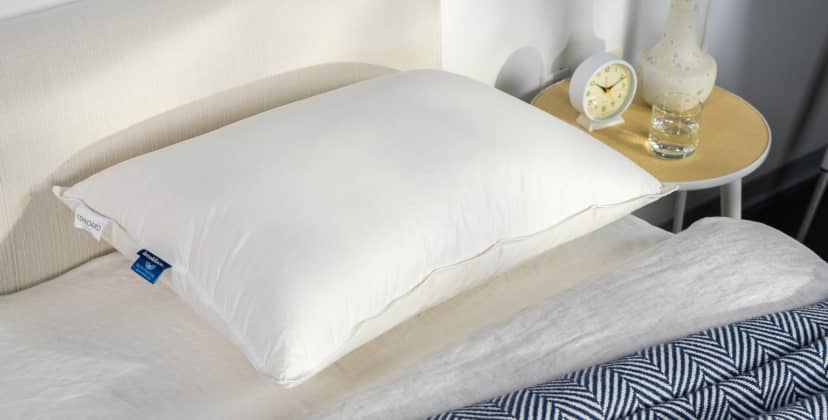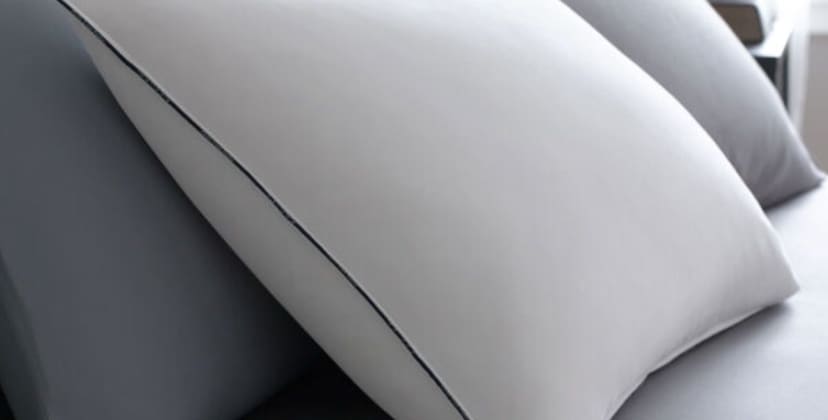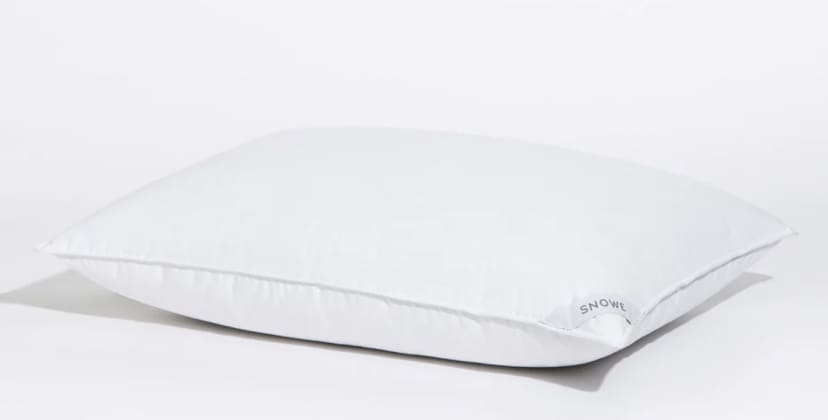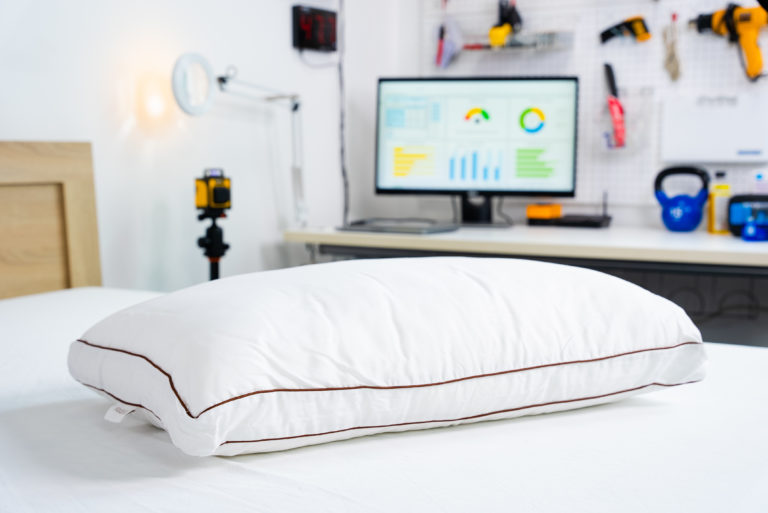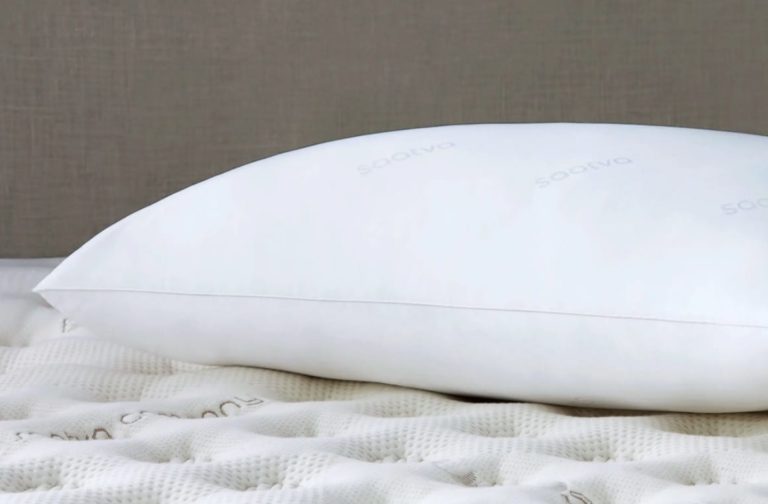When you buy through our links, we may earn a commission. Products or services may be offered by an affiliated entity. Learn more.
A comfortable and supportive pillow can help ensure that you get restful sleep each night, without experiencing shoulder or neck pain. When choosing a new pillow, consider what you prefer in terms of thickness, softness, temperature regulation, and sleeping position.
Sleepers who want a plush experience may prefer feather pillows. These pillows typically contain feathers, down, or a blend of both. Feathers tend to have more structure for support, while down is softer. Soft feather pillows conform to the shape of the head and neck, but they may not provide the same amount of pressure relief as latex or memory foam.
With so many options available, finding the right pillow may seem overwhelming. To help you narrow down your search, we’ll highlight the best feather pillows on the market, based on extensive product research, verified customer reviews, and testing. We’ll also break down the features, benefits, and drawbacks of feather pillows that you may want to consider.
The Best Feather Pillows
-
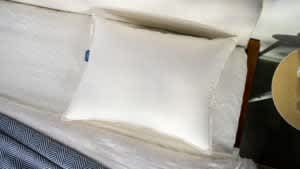
Best Overall
Brooklinen Down Pillow
Shop Now
-
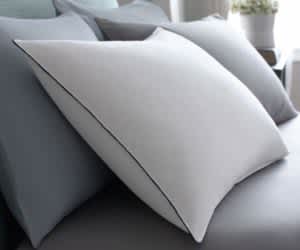
Best Value
Pacific Coast Feather Best Pillow
Shop Now
-
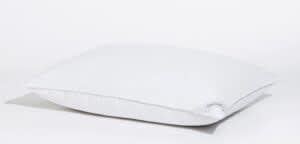
Best Luxury
Snowe Down Pillow
Shop Now
-

Most Comfortable
Quince Luxe Goose Down Pillow
Shop Now
-
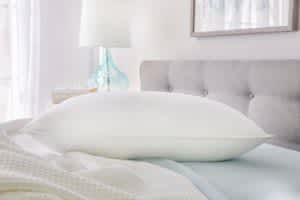
Best for Neck Pain
PlushBeds Hotel Chamber Down & Feather Pillow
Shop Now
-
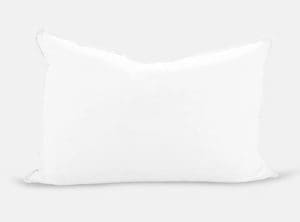
Best for Side Sleepers
Helix Down & Feather Pillow
Shop Now
-
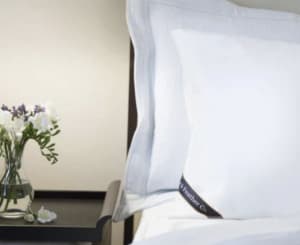
Best Hotel-Style
Down & Feather Company Hotel Collection Feather Pillow
Shop Now
-
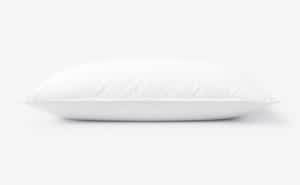
Best for Combination Sleepers
The Company Store Essentials Better Down and Feather Pillow
Shop Now
In-Depth Reviews
-
Pros
-
Three firmness options to suit different sleeper preferences
-
Each order comes with a trial period spanning an entire year
-
Down and feather clusters with a cotton sateen shell ensure a soft, cloud-like feel
-
-
Cons
-
Fill may trigger down allergies
-
Pillow should not be machine washed
-
Price Range
$109 – $149
Fill
Canadian white down clusters or down/feather blend
Firmness
Plush, Mid-Plush, Firm
With three firmness options to choose from, the Brooklinen Down Pillow can accommodate most sleeping positions and body types. The Plush option should suit most stomach sleepers, while the Mid-Plush is particularly suitable for side and back sleepers. Side sleepers may also benefit from the Firm Down Pillow. Standard and king sizes are available.
The cotton shell features a 400 thread count sateen weave for a smooth feel. While the Plush model is filled completely with Canadian white down, the Mid-Plush and Firm models have an inner feather core for more support.
Brooklinen treats the cover with Ultra-Fresh Antimicrobials to help keep the pillow clean. The Down Pillow requires spot cleaning, and should not be machine washed. You can use the dryer for fluffing if you have a setting that does not use heat. Leave the pillow outside to air out when weather permits. Dry cleaning is suitable for large stains, but it may degrade the down faster and remove the natural oils, which reduces the pillow’s lifespan.
You can exchange or return this product within one year of purchase if you aren’t happy with it. The company offers a refund to your original payment method, or you can opt for store credit. Shipping and returns are free within the U.S.
-
Pros
-
Luxuriously plush feel thanks to premium feather fill
-
Brushed cotton cover is exceptionally smooth
-
Special warranty lets you test the pillow to see if allergy symptoms arise
-
-
Cons
-
Not ideal for people with allergies
-
Shipping cost is not refunded if returned
-
Price Range
$64 – $74
Fill
Hyperclean Resilia feather fill
Firmness
Soft
A high-quality feather pillow can easily cost hundreds of dollars, but Pacific Coast has earned a stellar reputation for premium down and feather products with affordable price-points. One of the brand’s newest offerings is the Hotel Feather Best Pillow, which contains clusters of Hyperclean Resilia feathers. A mid-range loft coupled with an exceptionally plush feel makes the pillow best suited to side and back sleepers.
The pillow’s shell is composed of brushed cotton with a 230 thread count. The material has a very smooth feel and is also quite breathable. The feathers are cleaned at least eight times to wash out dust and dirt that can trigger symptoms for people who are allergic to feathers. However, Pacific Coast also backs each order with a 30-day allergy guarantee in case you still feel sniffly or sneezy after using the pillow.
Queen and king sizes are available. The pillow can be laundered at home by washing with mild detergent on a warm, gentle setting and drying on low heat. You can also use a protector to safeguard the pillow against spills and stains. The border is trimmed with thick piping to prevent tears from forming that allow fill to escape.
In addition to the allergy-free warranty, the Hotel Feather Best Pillow comes with a 30-night trial period and a 3-year manufacturer’s warranty against structural defects. Shipping is free for orders of $80 or more, but delivery for smaller purchases is reasonably priced.
-
Pros
-
Pure down fill creates a plush, cloud-like surface
-
Shell is composed of breathable, silky-soft cotton sateen
-
RDS certification ensures highest standards of ethical animal treatment
-
-
Cons
-
Shipping fee is not refunded if returned
-
Many customer service issues have been reported
-
Price Range
$165-$185
Fill
Duck down
Firmness
Soft, Medium, Firm
The Snowe Down Pillow embodies everything we love about luxe, hotel-inspired bedding. White down clusters make the surface feel exceptionally plush and cloud-like, while the cotton sateen shell makes the pillow breathable and silky-soft on the surface. You can also choose from three density levels based on your preferred sleep position, and Snowe allows exchanges if you aren’t satisfied with your initial selection.
Our hands-on tests show each density is best suited to different sleep styles. Side sleepers should consider the firm design, which provides ample cushioning to fill the space between the head and downward-facing shoulder — this helps ensure even alignment for those who use the side position. Back and stomach sleepers will likely prefer the medium or soft density pillows. These models compress more to limit elevation and prevent neck strain. Many of our testers enjoyed these density options, calling out their cloud-like surfaces for targeted pain relief in the neck and shoulders
Down naturally absorbs and traps heat, but this pillow’s shell helps offset this process to keep you cool. The pillow’s Responsible Down Certification should also appeal to animal-conscious shoppers, as this indicates Snowe adheres to high standards regarding animal treatment and welfare. You may wash and dry the pillow in your household machines if they are large enough to accommodate it. Dry cleaning is an alternative option. Standard and king sizes are available.
Given its luxurious design, the Snowe Down Pillow is reasonably priced, and standard shipping is free for all orders in the contiguous U.S. You may return the pillow or exchange it for a different density within two weeks of the delivery date.
Most Comfortable
Quince Luxe Goose Down Pillow
Use this link for the most current discount.
Shop Now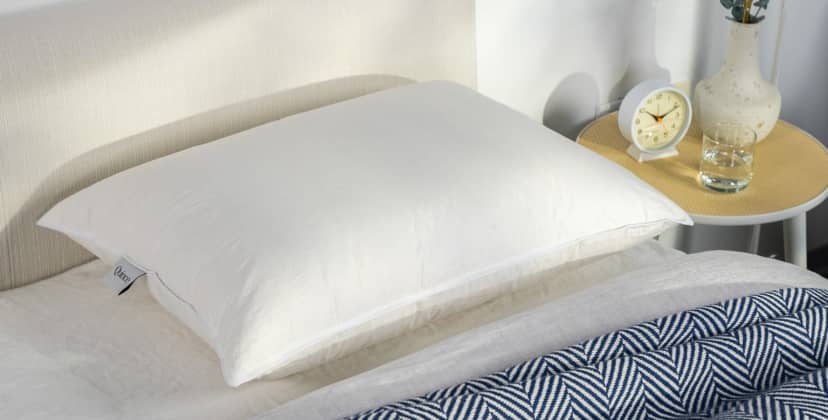
-
Pros
-
European white goose down fill creates a luxe and lofty feel
-
Two density options to accommodate different sleep positions
-
Double-stitch edges and perimeter piping help the fabric resist wear and tear
-
-
Cons
-
Frequent fluffing needed to maintain a full shape
-
Strong odor may be present for the first few nights
-
Price Range
$120 – $159
Fill
100% European white goose down
Firmness
Medium Soft, Medium Firm, Firm
Few bedding materials can match the softness of natural down. Quince’s Luxe Goose Down Pillow nicely showcases this quality, using 700 fill power European white goose down for an exceptionally plush and lofty feel reminiscent of the pillows you might encounter at a high-end hotel. You’ll notice some compression as you lay down your head, but the fill is dense enough to prevent deep sinkage that can lead to neck strain.
You can choose from two fill density options. The soft/medium design sinks more, so it should reduce stiffness and soreness for stomach sleepers and combination sleepers who switch between the back and stomach positions. Most side and back sleepers will probably prefer the medium/firm pillow, which props up the head more and won’t compress as much. Standard and king sizes are available.
The shell is composed of pure cotton with a sateen weave. People with acne, eczema, and other conditions causing sensitive skin should appreciate the fabric’s silky-smooth finish and gentle glide. That said, the shell is also durable thanks to double-stitch seams and thick piping along the border. These features help protect the fabric from rips and tears that can cause fill to escape and permanently damage the pillow. Although the pillow is technically machine-washable, it may be too large for certain household washers including those with agitators. To ensure a maximum lifespan, we recommend using a durable pillowcase or protector.
Affordable pricing and free shipping for all orders make the Luxe Goose Down Pillow a great option for shoppers with tight budgets. Quince’s 365-night trial period is among the longest in the online bedding industry, ensuring ample opportunity to test the pillow and decide if it meets your needs.
Best for Neck Pain
PlushBeds Hotel Chamber Down & Feather Pillow
Use this SleepFoundation.org link for the most current discount on PlushBeds pillows
Shop Now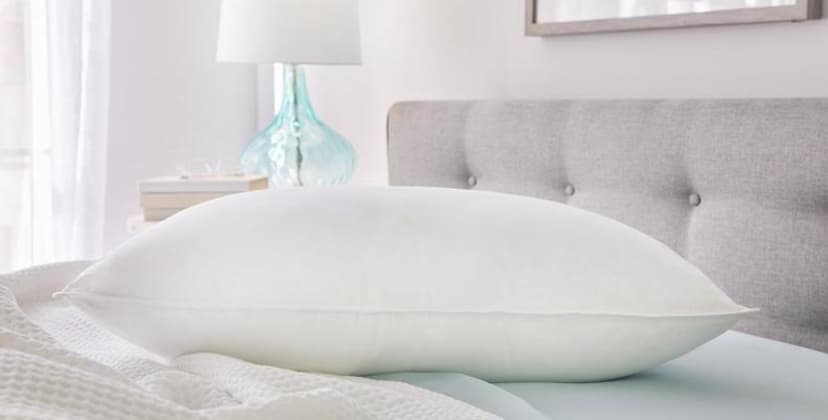
-
Pros
-
100% cotton cambric shell is soft to the touch
-
White down outer chamber cradles the head and neck to relieve pressure
-
Mid-range feel balances support and cushion
-
-
Cons
-
Not ideal for budget shoppers
-
There may be an adjustment period to get used to the pillow
-
Price Range
$120 – $136
Fill
550 fill power white duck down, feather fill
Firmness
Medium
The PlushBeds Hotel Chamber Down & Feather Pillow is a luxury product with hotel-like comfort to match. The softer outer chamber features 550 fill-power white down, which closely cradles the head and neck to alleviate pressure buildup. Meanwhile, a firmer inner chamber filled with a down and feather blend helps keep the head and shoulders aligned with the rest of the body. This pillow is also backed by a Responsible Down Standard certification, meaning the down filling was responsibly sourced with animal welfare in mind.
A shell made from 100% cotton cambric encases the pillow. The dense weave prevents feathers from poking through and escaping. Double stitching and German piping along the edges also make the pillow more durable. The pillow has a medium firmness, creating a balanced feel that supports the head while providing some contouring. This feel is best suited for side and back sleepers.
Most down pillows cannot be washed in household machines, but this product is fully machine-washable. Check that your washer is big enough to accommodate the pillow. Some down pillows have been known to damage washers with agitators. Wash in cold water and tumble dry on low.
Two sizes are available: standard and king. PlushBeds ships free to customers in the contiguous U.S. The company does not accept pillow returns for sanitary reasons, but each Hotel Chamber Down & Feather Pillow is backed by a 2-year warranty.
Best for Side Sleepers
Helix Down & Feather Pillow
Use this link for the most current discount.
Shop Now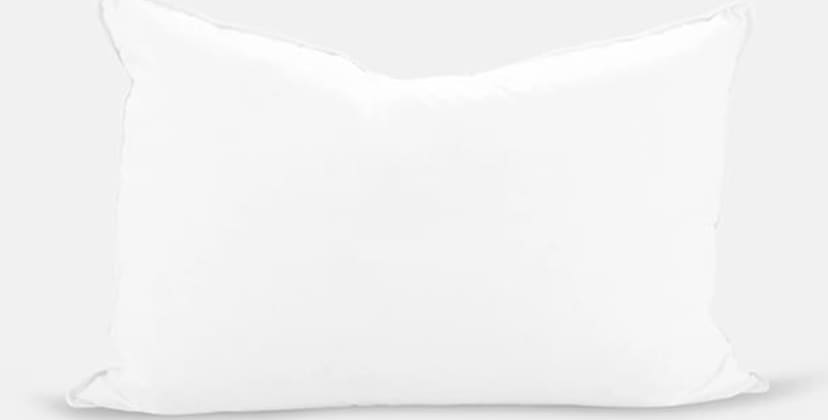
-
Pros
-
Feather blend core provides support
-
Lightweight cotton shell is highly breathable
-
Double stitching at the seam adds durability
-
-
Cons
-
Pillow is not machine-washable and should only be spot cleaned or dry cleaned
-
Some owners report an unpleasant smell for the first few nights
-
Price Range
$95 – $110
Fill
White Down, Feathers
Firmness
Soft
The Helix Down and Feather Pillow has three chambers for ample support and a soft, conforming feel. Our testers likened the pillow to lying on a cloud, but the chambered design helps ensure uncomfortable sinkage isn’t a major issue.
The inner core is filled with a blend of down and feathers engineered to provide neck and shoulder support. The two down outer layers with 550 fill power give sleepers the plush experience they typically expect from a down pillow. This innovative design also helps keep the fill evenly distributed. Double stitching along the edges creates a durable seam. The lightweight cotton cover is soft and breathable.
The Helix Down and Feather Pillow comes in standard and king sizes. Helix offers a 1-year limited warranty and a 100-day trial. Shipping is free for customers in all 50 states.
Best Hotel-Style
Down & Feather Company Hotel Collection Feather Pillow
Use this SleepFoundation.org link for the most current discount on Down & Feather Company pillows
Shop Now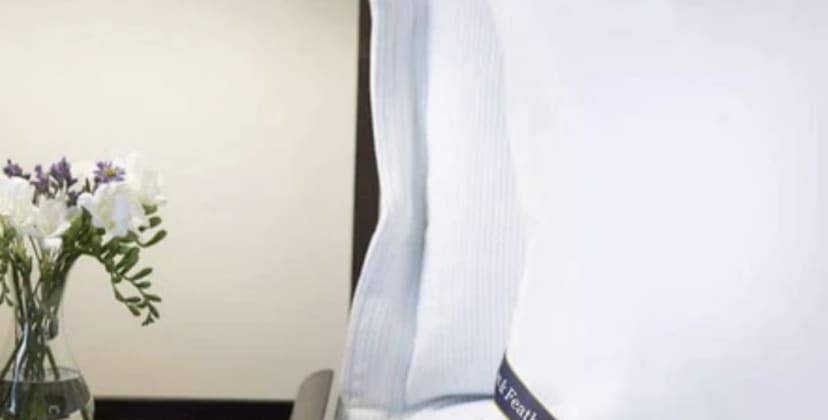
-
Pros
-
Hungarian goose down and feathers create a luxuriously plush feel
-
Available in four density levels to accommodate different sleep positions
-
Free firmness adjustment included with each purchase
-
-
Cons
-
Not machine washable, only able to be spot-cleaned
-
Free shipping does not include return shipping fee
-
Price Range
$99 – $129
Fill
Hungarian goose feathers
Firmness
Soft
The Down & Feather Company Hotel Collection Feather Pillow is a hotel-style model filled entirely with a blend of feathers and down. Available in four firmness options, the pillow has a luxuriously plush feel that caters to a wide array of sleep preferences.
Shoppers can choose between soft, medium, firm, and extra firm models. The firmer the pillow, the thicker the profile. The firmest and loftiest pillow is tailored for side sleepers, who benefit from pillows that are thick enough to support the neck but still offering cushioning for the head. Back sleepers should find the firm and extra firm models suitable, while the soft option is recommended for stomach or combination sleepers. For anyone who likes to squish their pillow, the softer models mold quite easily.
The fill is made from 75% Hungarian goose feather and 25% Hungarian goos down. The cover is made from 100% long-staple Egyptian cotton, which is known for its breathability and durability. The down and feathers have received certification from the Responsible Down Standard (RDS). The pillow comes in three sizes: standard, queen, and king.
The pillow comes with a 30-night sleep trial and 10-year warranty. Shipping is free for orders of at least $150. Down & Feather Company also offers a free pillow adjustment policy within one year of purchase. This policy allows you to exchange your pillow for a model that is one firmness level higher or lower, free of charge.
Best for Combination Sleepers
The Company Store Essentials Better Down and Feather Pillow
Use this SleepFoundation.org link for the most current discount on The Company Store pillows
Shop Now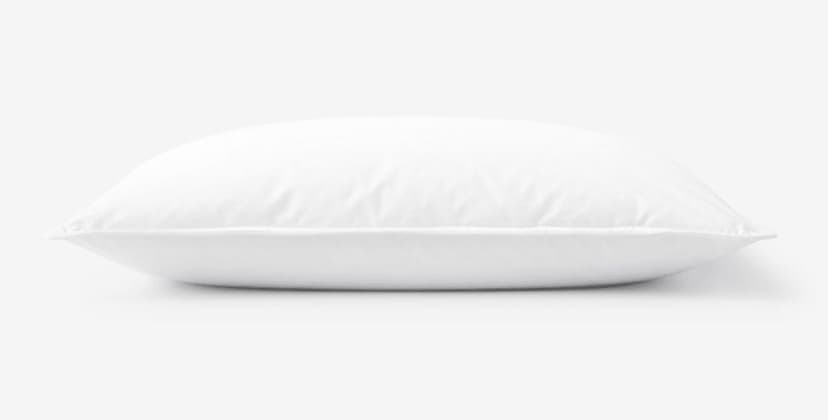
-
Pros
-
Four density options, each with a different firmness level
-
Equal blend of down and feathers ensures a balance of plushness and support
-
RDS certification indicates humane and ethical animal treatment
-
-
Cons
-
Some off-gassing smell when opened, which dissipates after a few days
-
Some firmness levels require frequent fluffing
-
Price Range
$65 – $131
Fill
50% down, 50% feathers
Firmness
Soft, Medium, Firm, Extra Firm
Many people enjoy the exceptional softness of feather pillows, but this is not an opinion everyone shares and a large number of sleepers feel most comfortable with a firm surface for their head and neck. The Company Store’s Essentials Better Down and Feather Pillow is available in four firmness levels: soft, medium, firm, and extra firm. This selection ensures most people can find at least one suitable option whether they want a plush pillow, a more supportive surface, or something in between.
An even blend of down and feathers makes up the fill, resulting in a balance of luxurious plushness from the former and reinforcement from the other. The fill is certified by the Responsible Down Standard, indicating the plumage is acquired through humane and ethical means. A breathable cotton shell encases the fill. You may machine wash the entire pillow, though The Company Store recommends using a front-loading washer.
Our testing shows your ideal density level probably depends on your primary sleep position. The side sleepers on our team preferred the firm and extra firm designs. Due to their thicker profiles, these pillows should fill the space between your head and downward-facing shoulder to correct uneven alignment — a common issue side sleepers face. Our back sleepers enjoyed the mid-level loft of the medium pillow, while stomach sleepers felt more comfortable on the low-loft design because they didn’t experience any neck strain.
The Essentials Better Down and Feather Pillow is available in standard, queen, and king sizes. While the price-point varies by size and firmness level, the pillow is affordable compared to down and feather models from competing brands. The Company Store offers free ground shipping, and expedited delivery for an additional charge, and backs each purchase with a lifetime guarantee.
How to Choose a Feather Pillow
Feather pillows typically are softer than other types, making them ideal for sleepers who like to sink deeply into their pillows. That said, not all feather pillows are the same. Many vary in their feather/down ratio, which affects the amount of support they provide. Firmness, loft, and shape should be kept in mind when choosing a feather pillow.
Shoppers may also want to consider if the feathers or down are sourced ethically. Vegan shoppers may want to consider a down alternative pillow instead.
What to Consider When Purchasing a Feather Pillow
Some feather pillows contain all feathers or all down, while others may have a mix of the two. If you don’t want your head to sink deeply into the pillow, you may prefer a pillow with more feathers than down, as this type of pillow tends to have more structure.
The Federal Trade Commission (FTC) mandates how companies label their feather and down pillows. The materials used to construct the pillow should be listed in the product description and on the pillow tags. Feathers and down are typically sourced from ducks or geese.
Fill
Feather pillows can contain down, feathers, or a feather/down blend. Pillows with 100% down can be harder to find and more expensive. Pillows with more feathers than down tend to be more affordable. Pillows that are filled with 50% to 80% down tend to balance the plush feel of down with the structure and support of feathers. Synthetic down alternative pillows are also available.
Sleeping Position
Your sleeping position and your pillow should work together to support your head, neck, and spine. The loft and firmness of the feather pillow you choose should help you maintain spinal alignment. Side sleepers usually benefit from a thicker, firmer pillow. Pillows with lower lofts are more suitable for individuals who sleep on their backs or stomachs.
Loft
Loft refers to a pillow’s thickness. Choosing a pillow with the highest loft is not always optimal, as the ideal loft will depend on your sleeping position, mattress firmness, and body type. People who sleep on their sides typically need a higher loft than stomach or back sleepers.
When choosing a down or feather pillow, shoppers may want to consider the fill power of the pillow. Fill power is a measurement of density, indicating how many cubic inches one ounce of down takes up. A higher fill power can indicate a loftier pillow.
Support
Support refers to how well the pillow keeps the head, neck, shoulders, and spine in alignment. Given that your pillow provides about 20% of your total sleeping surface, this factor is essential in choosing the right pillow. For more support, you may want to consider a pillow that has more feathers than down.
Firmness Level
Down and feather pillows tend to be softer than other models, due to the nature of the fill material. That said, many manufacturers offer feather pillows in soft, medium, and firm options. There are several factors that indicate firmness, including construction and the ratio of down to feathers.
Pillows constructed with inner support chambers or additional feather fill may feel firmer than pillows filled exclusively with down. Loft or thickness may not be an accurate measure of firmness if the pillow has mostly down, which tends to be softer than feathers.
Pressure Relief
Pressure relief helps prevent neck and shoulder pain from developing by keeping the spine aligned. Sleepers may find that they sink into down and feather pillows more, which can put strain on the neck and shoulders. Memory foam and latex pillows tend to be more supportive and pressure-relieving.
Shape
Most feather pillows have a rectangular shape and are produced in standard sizes. Some vendors sell longer body pillows with feather and down fill. However, availability is limited. Due to the softness of feathers and down, this type of fill is typically not used for contoured or ergonomically shaped pillows. If you experience neck and shoulder pain, you may want to consider a foam or latex pillow instead.
Price
The price of a feather pillow will depend on its fill and construction. Pillows with higher down ratios will cost more, especially those with 100% down. Feather pillows with little to no down are generally more affordable, and may appeal to shoppers with limited budgets.
Quality Materials
Material quality affects multiple factors, including support, comfort, temperature, and moldability. High-quality down and feather fill is more likely to keep its shape over time.
The quality of the cover is also important. Most sleepers prefer a breathable cover that helps prevent heat retention. For feather pillows, a pillow cover that prevents the fill from escaping is ideal.
Moldability
Moldability allows you to shape a pillow so that it supports your head and neck as you sleep. Because down is softer than feathers, down pillows tend to be more malleable.
Temperature Regulation
In general, feather pillows don’t sleep as warm as memory foam or other foam materials. That said, feathers and down act as natural insulation, and may sleep warm for some. A breathable cotton cover can help wick away heat and moisture for hot sleepers.
What Are the Pros and Cons of Feather Pillows?
Shoppers should consider potential benefits and drawbacks when shopping for a feather pillow. While feather pillows can provide a luxurious, lofty feel, this type of pillow may be too soft for some sleepers to get the support they need.
| Pros | Cons |
|---|---|
|
|
Who is Best Suited to a Feather Pillow?
People who sleep on their backs or sides and like to cuddle their pillow may prefer a feather pillow. Depending on the materials and construction, feather pillows can also be beneficial for hot sleepers.
Feather pillows may not be advantageous for people with allergies, those who awaken easily from noise, or consumers who prefer vegan products.
Feather pillows are particularly suitable for:
- Side and Back Sleepers: People who like to sleep on their side or back may find feather pillows quite comfortable. Back sleepers tend to benefit from a medium loft pillow that conforms to the shape of their head and neck. Side sleepers typically need a high loft pillow that keeps the head and neck aligned.
- Sleepers Who Cuddle the Pillow: Feather pillows can be ideal for side sleepers and others who like cuddling their pillow. Feather pillows are highly moldable. Sleepers can shape the feather pillow for the ideal sleeping position and preferences.
- People Who Sleep Hot: Sleepers who easily get overheated at night may appreciate a feather pillow. Feathers trap less heat than other materials, which can help keep sleepers comfortable throughout the night. However, down is more likely to retain heat, which may make hot sleepers less comfortable.
Feather pillows are less suitable for:
- Sleepers with Allergies: Pillows can attract dust mites, which may irritate allergies. Cleaning your pillow regularly can prevent the buildup of certain allergens, but feather and down pillows often require spot cleaning or professional cleaning. Allergy sufferers may consider a machine-washable down pillow or one with a down alternative fill for easier maintenance.
- People Sensitive to Noise: Sleepers who are sensitive to noise or wake up easily might not like sleeping on a feather pillow. The quills sometimes make a rustling noise when they shift around, which may sound loud to sensitive sleepers.
- Vegan Shoppers: Vegans and others who oppose using animal-based products should avoid feather and down pillows. These shoppers may want to consider a down alternative pillow instead.
Which Feather Pillow Sizes Are Available?
Feather pillows are typically available in the following sizes, though sizing and availability will vary between manufacturers.
- Standard: Typically measuring 20 inches by 26 inches, standard is the most common pillow size. It also tends to be the most affordable. Standards fit well on twin, twin XL, or full mattresses. Couples who share larger beds can use standard size pillows as well.
- Super Standard: This size usually measures 20 inches wide and 28 inches long. People who find standard pillows too small may prefer the super standard. This size is less common.
- Queen: Queen size pillows are common. They typically measure 20 inches wide by 30 inches long. The queen size may be an ideal choice for sleepers who shift positions or move around during the night.
- King: King pillows measure 20 inches wide and 36 inches long. Like the queen size, the king size suits sleepers who move around while sleeping. The larger size also makes it suitable for people who sleep on a king size bed, or those who like to have a backrest while sitting up in bed.
- Body Pillow: Body pillows can be 54 inches or longer. Feather and down body pillows are less common, but many body pillows are filled with down alternative. A body pillow supports a variety of sleeping positions, especially for pregnant women or people who like snuggling with a pillow while sleeping.
There are additional considerations that shoppers should keep in mind when shopping for a feather pillow. These factors include budget, care and maintenance, and the difference between feather and down pillows.
Frequently Asked Questions About Feather Pillows
How much do feather pillows cost?
Many feather pillows cost between $25 and $75. Down pillows are more expensive, costing between $80 to $200 on average. Fill content and construction largely determine the price. With feather/down blends, the larger the down ratio, the more expensive the pillow will be. Down alternative pillows tend to be more affordable, and basic models usually cost between $20 and $30.
Can you wash feather pillows?
Most feather pillows can be washed, but make sure to read the label to determine what cleaning method to use. Some feather pillows are machine-washable with cold water or a delicate setting. Other pillows may need dry cleaning.
You can fluff some feather pillows in the dryer with a low heat or air fluff setting. Machine washing two pillows together can help ensure that the washing machine doesn’t get out of balance.
Pillows of all types need cleaning at least every six months to prevent the buildup of dead skin cells, sweat, and oil.
How often should I replace feather pillows?
You may want to replace your feather pillow every two to three years. Using a pillow cover will help extend the life of the pillow. You should replace your feather pillow if it has one or more large stains that cannot be removed, or if the down and feather fill has been damaged by moisture.
It may also be time for a new pillow if you regularly wake up with neck or shoulder pain, headaches, or fatigue. Changing your preferred sleeping position is another reason to get a new pillow, as you may need one with a different firmness or loft. You should always replace pillows when they no longer give you the support you need. Regularly replacing your pillow is essential for hygienic purposes.
Where can I buy feather pillows?
You can find most standard, queen, and king sizes at brick-and-mortar and online stores. Most feather pillows are available at pillow and bedding manufacturers, department stores, or home furnishings retailers. Feather body pillows are harder to find.
Are feather pillows adjustable?
Feather pillows are not usually adjustable, as this would require the addition or removal of fill. That said, shoppers can often choose between several different loft or firmness options.
Since feather pillows are highly moldable and conforming, sleepers can also scrunch the pillow to their preferred shape. Fluffing the pillow regularly helps it maintain its loft and prevents flattening over time.
What is the difference between feather pillows and down pillows
Feather pillows and down pillows may differ in construction, materials, and price. Feathers make up the coarse outer plumage on birds. Down is the soft, insulating plumage found underneath the feathers. As a result, feather pillows tend to have more structure and support, while down pillows are softer.
Down typically retains heat more than feathers, making down pillows less suitable than feather pillows for people who sleep hot. Feather pillows tend to be more affordable than down pillows.

Still have questions?
Our product experts have extensive experience testing just about every sleep product on the market.
Send an email to AskAnExpert@sleepfoundation.org with your questions and we’ll help you find exactly what you’re looking for.

